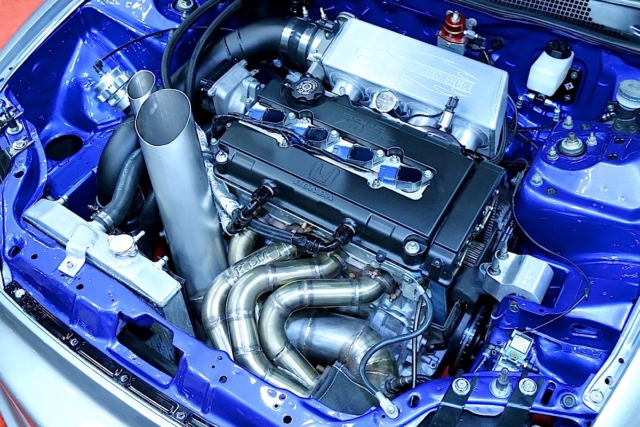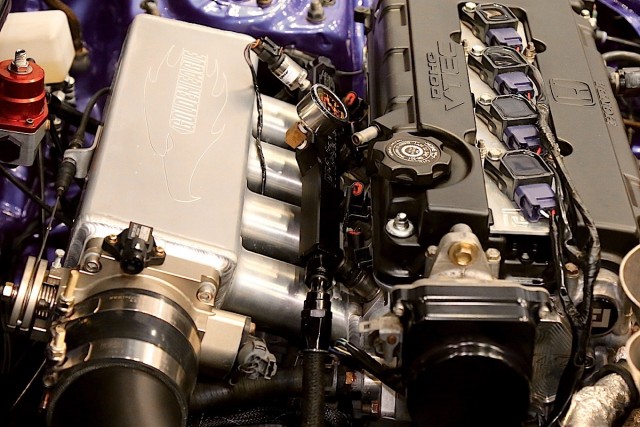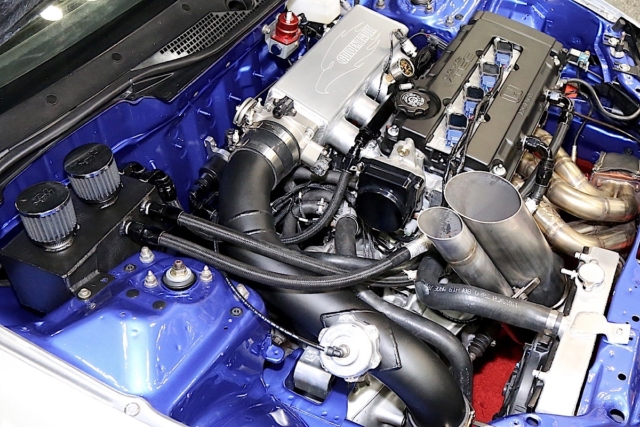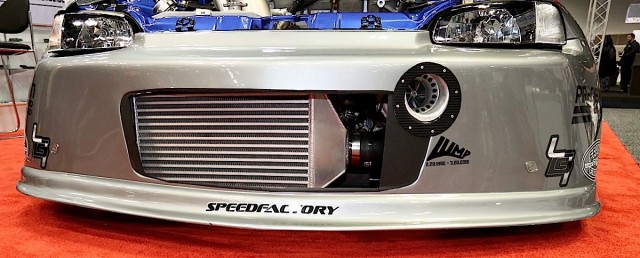 [1]Matthew McCreery set a simple goal of 1,000 horsepower when building up a Honda B18c1 engine for his ’94 Civic coupe that is set up to run at Import Face-off [2] events.
[1]Matthew McCreery set a simple goal of 1,000 horsepower when building up a Honda B18c1 engine for his ’94 Civic coupe that is set up to run at Import Face-off [2] events.
“Basically, it’s built to make 1,000 horsepower,” says McCreery, who was showing off the car in the Hondata [3] booth at this year’s PRI show. “Usually try to make 800 on the dyno and work up from there on the track. To be competitive in our class, 1,000 horsepower is where we need to be.”
The build started with a stock GSR block that was machined for Darton [4] sleeves, allowing a 3 mm overbore to 84 mm.
 [5]
[5]Closer look at the first intake built by Golden Eagle with a 6-liter plenum. The fuel injectors are from SouthBay.
“We can make 1,000 to 1,200 horsepower with the stock steel crankshaft,” says McCreery, adding that the stroke remained stock at 89 mm to end up with a total displacement of just a touch under two liters.
Rounding out the rotating assembly are Crower [6] steel connecting rods, off-the-shelf JE [7] asymmetrical pistons that provide a 10.5:1 compression ratio and an ATI [8] damper.
“We use steel rods in this motor but next year will probably go to aluminum,” adds McCreery. “We’ll go 10,500 rpm and the bearings take quite a bit of abuse from the steel rods.”
 [9]
[9]The starting foundation is a stock GSR block that is fitted with Darton sleeves, allowing for a 3 mm overbore.
The engine boasts unported stock Honda cylinder heads that were upgraded with stainless steel intake valves, Inconel exhaust valves, stiffer springs and titanium retainers from Supertech [10]. The Pro series cams are from Skunk2 Racing [11].
“I just rolled with their suggested cam specs,” says McCreery, adding that he degreed in the cams and checked the valve-to-piston and valve-to-valve clearances. “If we need to make adjustments on the dyno, we’ll do so.”
The turbo is a Precision [12] 67/66 dual-ball-bearing T4 unit.
“A lot of [competitors in class] run a 72 mm turbo while I run a 67,” explains McCreery. “I like the 67. It seems to short track better than the 72.”
KLM Fabrication [13] handled the header and intercooler construction while McCreery was responsible for the exhaust outlet and intercooler ducts. Golden Eagle [14] designed the intake manifold.
“It’s their first 6-liter intake,” says McCreery. “It has internal velocity stacks, and we’ve been doing testing with it.”
Other features include TiAl [16] blow-off valve and wastegate, Skunk2 90 mm throttle body and SouthBay [17] 2,200 cc fuel injectors. Controlling the fuel and spark is a Hondata S300v3.
“It made 800 horsepower on the dyno with 28 to 29 pounds of boost, but at the track you’ll get anywhere from 30 to 40 pounds. We’ll turn it up as much as we can as long as the track is there,” sums up McCreery, adding that the car’s best quarter-mile time is 9.3 @ 163 mph. “It’s got more potential but we try not to lean on it too hard with the steel rods.”
